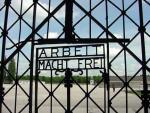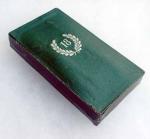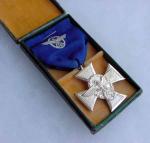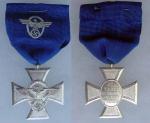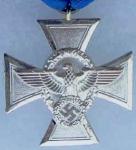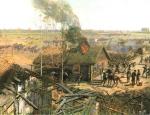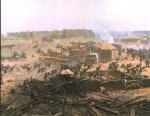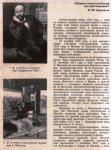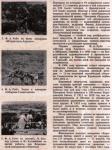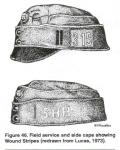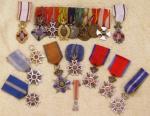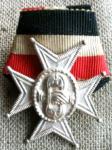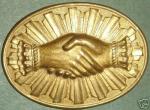-
Posts
9,099 -
Joined
-
Last visited
-
Days Won
4
Content Type
Profiles
Forums
Blogs
Gallery
Events
Store
Everything posted by Kev in Deva
-
Hallo Gents, a very informative original Sniper training film, the film was produced by the Luftwaffe, has been dubbed with English, shows training on Camo, judgeing distance, Field Craft, Tips and Tricks etc..etc... The section on Puppets to fool the enemy is very interesting, as is the sniper umbrella!!. http://video.google.com/videoplay?docid=-4...;q=world+war+ii Opps Kevin in Deva.
-
Hallo Gentlemen, a really nice helmet and a great connection to a piece of history some people would have us forget, or even deny the place exsisted, back in the 1990s I had chance to visit the site in question and found it to be a very moving experience, while some Holocaust historians do not rate Dachau as a Death Camp, there was a large amount of Death and suffering caused there, even one person suffering was one to many in my opinion. Some Facts & Figures with regards Dachau Concentration Camp: The Dachau concentration camp was opened on March 22, 1933 in a former gun powder factory. It was to be used as a political re-education camp. The first prisoners were 200 members of the Communist and Social Democrats political parties who were arrested after the Reischstag (German Congressional building) was deliberately set on fire on the night of February 27, 1933. Some of the first prisoners were members of the Congress, who were suspected of plotting to overthrow Hitler who had just taken office as the German Chancellor on January 30, 1933. They were at first held in Landsberg prison which was the same prison where Hitler served time after his attempt to take over the government on November 9, 1923. (We must not forget that Concentration camps were first used by the British in the Boer War when 76,000 women and children were incarcerated in South Africa, deaths occured in the British Camps, but not in the deliberate way the Nazi's used them, more so from ignorance and ill supplies to meet the demand of the amount of people incarcirated, leading to famine and sickness.) The Soviet Union had an extensive network of concentration camps, called gulags, which were first opened in 1918 after the Communist revolution in November 1917. The gulags continued to operate into the 1950ies and 4.5 million+ out of the 18 million inmates died in the gulags. Dachau is recognized as the first official concentration camp in Germany, but there were other camps opened around the same time. Dachau was the first camp opened in the state of Bavaria. A camp was set up at Oranienburg near Berlin around the same time that the Dachau camp was opened in March 1933. The Oranienburg camp was rebuilt as the Sachsenhausen camp, starting in 1936. The rebuilding of Dachau began around the same time period. According to the Nazi records, the total number of registered inmates was 206,206. According to the US Seventh Army report, there were 221,930 inmates brought to the camp between 1933 and April 26, 1945 plus an additional 7,000 who were brought to the camp in the last few days before it was liberated. These 7,000 prisoners had been evacuated from other camps and were not registered when they arrived at Dachau. The precise number of Jewish deaths at Dachau is unknown. According to the Nazi camp records, there were a total of 31,951 recorded deaths from all causes at Dachau, which included people of all religions and ethnic groups. Dachau was primarily a camp for political prisoners, common criminals and religious dissidents. The majority of the prisoners who died in the camp were Catholic. It was the policy of the Nazis to send the Jews first to ghettos and then to extermination camps in Poland, not to concentration camps in Germany. When the death camps in Poland were closed between June 1944 and January 1945, the surviving Jews were transferred to camps in the Greater German Reich, including some who were brought to Dachau and then sent to the sub-camps of the main Dachau camp. In the final days of the war, Jewish prisoners in the sub-camps were brought to the Dachau main camp, along with Jewish prisoners evacuated from Buchenwald. There were 2,539 Jews at the Dachau main camp when it was liberated. According to a book published by the US Seventh Army immediately after the war ("Dachau Liberated, The Official Report by The U.S. Seventh Army*), there were a total of 29,138 Jews brought to Dachau from other camps between June 20, 1944 and November 23, 1944. This report says the Jews were brought to Dachau to be executed and that they were gassed in the gas chamber* disguised as a shower room and also in the four smaller gas chambers*. * According Dachau Museum Director Barbara Distel, the gas chamber at Dachau, which was disguised as a shower room, was never used for any purpose. The Dachau Memorial Site also says that the four smaller gas chambers were disinfection chambers used to kill lice in the camp clothing. Although people died in the Dachau camp, including some Jews, Holocaust historians do not refer to Dachau as a death camp because Jews were not sent there for the express purpose of being murdered. The six Nazi death camps where Jews were gassed were Chelmno, Majdanek, Sobibor, Treblinka, Belzec, and Auschwitz-Birkenau, all of which were in what is now Poland. Approximately 150 to 200 prisoners were forced to participate in experiments conducted by Dr. Sigmund Rascher for the German Air Force. About half of them died as a result. The Nazis claimed that the subjects were chosen from the German criminals or the Russian Communist Commissars in the camp who had been condemned to death. At least one of the subjects was Jewish; he had been condemned to death for breaking the Nuremberg Law against race mixing. There were also approximately 1200 Dachau inmates who were used for experiments, done by Dr. Karl Schilling, to find a cure for malaria. The subjects of these experiments were Catholic priests who were prisoners in the camp. Incoming inmates at Dachau were not tattooed. Auschwitz-Birkenau was the only camp where prisoners were tattooed. However, prisoners who were transferred to Dachau after the Auschwitz-Birkenau camp was closed already had a tattoo when they arrived. Dachau was primarily a camp for men, but in the last days of the war, a few women were transferred to Dachau from other camps that had been evacuated. When the Dachau camp was liberated, there were 225 Jewish women there. They had arrived at Dachau only a few weeks before liberation. There were also a few women who were held as "special prisoners" in the bunker, as the camp prison was called; they were the wives of VIP prisoners, such as Kurt von Schuschnigg, the former Chancellor of Austria. The very first prisoners who died at Dachau were buried in the Old Cemetery in the town of Dachau. Later, the bodies of those who died at Dachau were cremated in the ovens there in an attempt to prevent epidemics. The ashes were put into urns and sent to the families of the deceased during the early days of the camp. Ashes of Dachau victims from other countries were buried in the woods on the northwest side of the Crematory. These graves of unknown victims are marked with a Jewish monument and Catholic Crosses. There is also a box of ashes in front of a wall with the inscription "Never Again," located in front of the east wing of the Museum. Inmates who died after the camp was liberated are buried in the Waldfriedhof, another cemetery in the town of Dachau. A new cemetery on Leitenberg hill was opened by the Nazis in October 1944 when they ran out of coal to cremate the bodies of the dead inmates. There are 7,439 mostly unknown Dachau prisoners buried in mass graves there, including some who died after the camp was liberated. Leitenberg hill is on the outskirts of the town of Dachau in the former suburb of Etzenhausen. After Dachau was liberated, there were 800 bodies of the victims cremated in the ovens at Dachau; their ashes are presumably buried at Dachau. Dachau was liberated on April 29, 1945 by soldiers of the US Seventh Army. There were two divisions involved, the 42nd Infantry (Rainbow) Division commanded by Brigadier General Henning Linden and the 45th Infantry (Thunderbird) Division, commanded by Lt. Colonel Felix Sparks. Dachau was not the first camp to be liberated. That distinction belongs to Majdanek in Lublin, Poland, which was liberated by the Russian Army on July 23, 1944. The first camp to be liberated by the American Army was Buchenwald, on April 11, 1945. The first soldier to enter the entire Dachau complex, which included an S.S. garrison, an S.S. training center and the prison compound, was probably Pfc. John Degro, the lead scout of Company I, 3rd Battalion, 157th Infantry Regiment, 45th Division of the US 7th Army, who entered through the railroad gate into the S.S. section of the camp. Lt. William Cowling III of the 42nd Division of the US 7th Army claims to have been the first American soldier to enter the prison enclosure inside the Dachau complex. Both the 45th Infantry Division and the 42nd Infantry Division were invited to put up a plaque in honor of their liberation of Dachau, but the 45th declined. The 20th Armored Division was providing tank support for these two Infantry Divisions which were on their way to capture Munich when they came across the Dachau camp. When the 45th declined to be honored, the 20th Armored accepted an invitation to put up a plaque in their honor on the wall opposite the plaque in honor of the 42nd. According to the last roll call taken at Dachau on April 26, 1945, three days before the liberation, there were 30,442 prisoners in the main camp which is now the Memorial Site. There were an additional 37,223 in the sub-camps surrounding Dachau. Many of the Dachau prisoners were survivors who had been evacuated from other camps and had only arrived in Dachau a few weeks before the liberation. Additional prisoners from other camps arrived at Dachau after the final roll call and the official count by the US Seventh Army at the time of liberation was 31,432 prisoners in the camp. The Nazis were fearful that Jewish and Russian prisoners would exact revenge by raping and killing German civilians and looting their homes if they were liberated. Three days before the American Seventh Army arrived to liberate Dachau, the Nazis evacuated 1,759 Jews from the camp by train. They also evacuated an additional 6,887 prisoners, half of them Jews and the other half Russian POWs, and marched them toward the South Tyrol. 137 privileged and high ranking prisoners at Dachau were also evacuated for their own safety in case there was violence when the liberators arrived. Many of the 31,951 deaths resulted from epidemics of typhus and other contagious diseases. There were horrendous epidemics in all the concentration camps after survivors from Auschwitz were brought to Germany in late 1944 and early 1945. Typhus is caused by body lice and the epidemic was carried to Germany from Poland by prisoners who had body lice. Out of the 31,951 deaths in Dachau, 13,158 of them occurred during the typhus epidemic in the last four months that the camp was in operation, according to the Nazi records. According to the US Seventh Army official report, there were 16,717 non-Jews who were executed at Dachau between October 1940 and March 1945. The report also says that 15,724 prisoners were brought to Dachau and were not included in the official count of 206,206 registered inmates. Many of those who were executed at Dachau were Russian POWs who were shot* on orders from Adolf Hitler who issued a command before the invasion of Russia in 1941 that all captured Communist Commissars in the Soviet Army should be executed. * These men were shot on the S.S. Rifle Range and not in the camp itself. There were 900 prisoners who were dying from typhus in Dachau when the American liberators arrived; thousands more were sick from typhus and other contagious diseases. They were emaciated because they were too sick to eat. The prisoners were not deliberately starved; food was scarce all over Europe during the war and food was rationed for civilians. In the early days of the camp, before the war, the Dachau prisoners were well fed. Those who did heavy work received four meals a day, including the traditional German "second breakfast." During the last days of the war, when railroad lines were being bombed, the transportation system broke down and it was hard to get food to the camp. Nevertheless, the prisoners were fed right up to the day of liberation and the majority of the survivors were in reasonably good health. In the month of May 1945, there were 2,226 Dachau inmates who died in the typhus epidemic which was still raging. There were 196 more deaths in June 1945. The epidemic was finally brought under control by the Americans with the use of DDT to kill the lice and typhus vaccine to stop the spread of the disease. The Germans did not have DDT or vaccine to prevent typhus. The Dachau concentration camp was never a secret. The town residents saw the inmates on a daily basis when they were brought to the town to work in factories there. Prisoners also worked on building roads and a new cemetery in the town. New inmates arrived at the train station in the center of town and walked two miles through the town to the camp. The townspeople tried to help the inmates in any way they could. The town residents sent packages of food and medicine, which the Nazis distributed to the inmates. When work details from the camp came to the town, the residents risked being imprisoned themselves in order to give food to the inmates while they were working, a practice which was forbidden by the Nazis. The pharmacies gave free medicine to the inmates when they were working in the town and the town dentist secretly provided dental care for the prisoners. The Nazis honored the 1929 Geneva Convention with respect to prisoners from all countries which had signed the convention, including allowing the Red Cross to distribute food packages in the concentration camps, beginning in August 1942. Between the Autumn of 1943 and the end of the war in May 1945, the Red Cross distributed 1,112,000 packages containing 4,500 tons of food to the Nazi concentration camps including Dachau and even the Auschwitz death camp. All the original buildings in the prison compound, which were part of the gunpowder factory, used in WW1, were torn down and replaced by new buildings, starting in 1936. Of those new buildings, only the administration building, the gate house, the bunker, and the two crematoria buildings outside the prison compound are still standing. The first guards at the "Dachau Prison Camp" were Bavarian state police officers from Munich who were requisitioned by Reichsführer-SS Heinrich Himmler, the Acting Chief of Police of Munich since March 9, 1933. Police Captain Schlemmer was in command of the police unit. On April 1, 1933 Himmler was appointed Commander of the Bavarian Secret Police; at the same time he was also put in charge of all existing and future concentration camps by a special decree of Minister of Interior Adolf Wagner. After April 1, 1933, Himmler was also in charge of the political auxiliary police, a unit of the Bavarian State Police that was now a part of the SS. The first guard unit of 60 S.S. men to enter Dachau after April 1 was under the command of SS-Sturmführer Robert Erspenmüller. The SS officially took over the guarding of the camp on April 11, 1933, by which time the number of guards had increased to 138. By April 30, 1933 there were 234 S.S. men guarding the inmates at Dachau. With the changing of the guards on April 11, Bavarian State Police Captain Schlemmer was replaced by Captain Winkler, but the state police no longer had any power over the guards. The guards were now under the command of SS-Hauptsturmführer Hilmar Wäckerle. On April 19, 1933 Wäckerle began referring to himself as the Camp Commandant. Wäckerle was instructed by Himmler to draw up a set of rules for discipline in the camp. His rules were extremely harsh and a number of prisoners died after being punished. Some of these victims were Wilhelm Aron , Dr. Rudolf Benario, Fritz Dressel, Sepp Götz, Ernst Goldmann, Arthur Kahn, Erwin Kahn, and Karl Lehrburger. Herbert Hunglinge committed suicide to escape the unbearable conditions in the camp. The deaths in the Dachau camp came to the attention of the Munich prosecutor after Sophie Handschuch made a formal complaint in 1933, demanding to know the true cause of death of her son who had been an inmate at Dachau. After an investigation by the Munich police, W?ckerle was charged with murder for the deaths of Louis Schloss on May 16, Leonard Hausmann on May 17, Dr. Alfred Strauss on May 24 and Sebastian Nefzger on May 25. Because of the criminal charges, Himmler was forced to relieve Wäckerle of his command, as of June 25, 1933. The charges against Wäckerle were later dropped and he left Dachau on July 15, 1933. He was posted to a new position in Stuttgart. After the war started, Wäckerle was sent to the front as a Waffen-SS officer; he died in battle. Hilmar Wäckerle was succeeded by Theodor Eicke who took command on June 26, 1933. Eicke was promoted to Inspector of all the Concentration Camps and was later transferred to headquarters in Oranienburg. Eicke was killed in a plane crash during the war. The next Commandant of Dachau was Heinrich Deubel who was dismissed by Heinrich Himmler after a few months for being too lenient with the prisoners. He was succeeded by Hermann Baranowski, who was subsequently transferred to the Sachsenhausen camp where he became the first Commandant there. Between April 1936 and 1941, the Commandant of Dachau was Hans Loritz; he was later transferred to Sachsenhausen where he became the next Commandant, succeeding Baranowski. Loritz committed suicide in February 1946 after he was arrested as a war criminal and imprisoned by the Soviet Union. Loritz was replaced by Alex Piorkowski who served as the Commandant of Dachau for six months in 1941 - 1942. Piorkowski was fired from his position by Himmler. He was accused of murder and was tried by a special SS court headed by an S.S. officer, Konrad Morgen. He was not convicted, but was nevertheless expelled from the Nazi party. Piorkowski was also tried by an American military tribunal at Dachau; he was convicted and was hanged in 1948. Piorkowski was replaced by Martin Gottfried Weiss who served as the Commandant of Dachau from September 1942 to August 1943. Weiss had previously been the Commandant of the Neuengamme camp from April 1940 to August 1942. He was transferred to the Majdanek camp in Poland where he was the Commandant from September 1943 to May 1944. Weiss was then promoted to be the Inspector of all the Concentration Camps. Weiss was replaced by Wilhelm Weiter who was the Commandant of Dachau from September 1943 to March 1945. Weiter committed suicide on May 6, 1945 after being captured by US forces in Austria. The Commandant of the Dachau concentration camp, when it was liberated, was Martin Gottfried Weiss. He had initially replaced Alex Piorkowski who had served as Commandant for 6 months in 1941 - 1942. Weiss had previously served as the Dachau Commandant from 1942 until 1943. He was then transferred to the Majdanek death camp, after the Majdanek Commandant, Karl Otto Koch, had been arrested by the S.S. and put on trial for crimes committed while he was previously the Commandant of Buchenwald. Wilhelm Weiter replaced Weiss in 1943, but Weiss was subsequently brought back to Dachau in March 1945 to take over in the final weeks of the war. Weiss left the Dachau camp on April 28, 1945, the day before it was liberated, leaving SS Lt. Johannes Otto in charge. Weiss was hanged on May 29, 1946 after being convicted in the first proceedings of the American military tribunal at Dachau, which began on November 15, 1945. The Dachau concentration camp was surrendered by 2nd Lt. Heinrich Wicker to the 42nd Infantry Division of the US Seventh Army, accompanied by a Red Cross representative carrying a white flag. He was later reported missing by his mother and sister, who had been staying at the S.S. garrison while they were visiting him. He is presumed to have been killed after the surrender. The first inmates were 200 Communists who were brought by the Bavarian State Police in four trucks from the Landsberg am Lech prison to Dachau on March 22, 1933. They were registered alphabetically, so Prisoner No. 1 was 24-year-old Claus Bastian, a law intern from Munich. He was released from Dachau in September 1933. He had a successful career as a lawyer and lived for awhile in the town of Dachau. Some notable prisoners were: The Rev. Martin Niemöller - one of the founders of the Confessional Church Dr. Johannes Neuhäusler - Catholic Bishop Kurt von Schuschnigg - former Chancellor of Austria, who opposed the Anschluss Edouard Daladier - premier of France at the time of the German invasion Leon Blum - premier of France in 1936 and 1937 and France's first Jewish premier Georg Scherer - native of city of Dachau who later became Mayor of Dachau Other well know survivors were Josef Müller , Leonard Roth, Walter Neff, Richard Titze, Eric Preuss, Nico Rost, Bruno Bettelheim, Arthur Haulot, Max Mannheimer, Hjalmar Schacht, Oskar Müller, Zola Philipp, Joel Zak, Kurt Schumacher, Georges Walraeve, Eric Braun, Werner Cahnmann, General Andre Delpech, Alfred Haag, Josef Huber, Hans Kaltenbacher, Otto Kohlhofer, Otto Pies, Heinrich Stöhr, Rene Simon, Wadim Sobkov, Vldek Spiegelmann, Walter Cieslik, Robert Eisinger, Bernt Englemann, Otto Färber, Leopold Figl, Paul Hussarek, Eugen Kessler, Edmond Michelet, Reimund Schnabel, Hans Schwartz, Walter Vielhauer, and Alfred Werner. When Dachau was liberated, there was one American, Lt. Rene J. Guiraud, a member of the US Office of Strategic Services (OSS) who had been arrested as a spy. There were also 5 other American civilians who were prisoners in the camp, according to Marcus J. Smith in his book, "The Harrowing of Hell." According to Nerin E. Gun, a survivor of Dachau, there were 11 Americans imprisoned at Dachau at various times in its history. According to a U.S. Seventh Army report written by Lt. Col. Walter J. Fellenz, there were 17 SS-Totenkopf guards in Tower B who were killed during the liberation of the camp by soldiers of the 45th Thunderbird Division and the 42nd Rainbow Division. According to Col. Howard A. Buechner, the chief medical officer of the 45th Infantry Division, who arrived on the scene moments after the shooting of Waffen-SS soldiers at Dachau, there was a total of 520 S.S. soldiers executed by the 45th Infantry Division and 40 SS guards were shot or beaten to death by the liberated prisoners. Col. Buechner wrote his version in a book entitled "The Hour of the Avenger." In his book "Deliverance Day," Michael Selzer wrote that the American liberators marched 122 of the Waffen-SS soldiers who had surrendered to a wall, and with their hands up in the air, shot them with machine guns. According to Selzer, the Commander of the S.S. Camp Complex, Heinrich Skodzensky, had only moments before surrendered the S.S. camp to Colonel Jackson of the 45th Infantry Division of the US Seventh Army, saying in English, "I am the commanding officer of the guard in the camp, and I herewith surrender the camp to your forces." Skodzensky was shot along with the others, according to Robert H. Abzug in his book "Inside the Vicious Heart." According to 45th Division Commander Col. Felix Sparks, the number of German P.O.Ws who were executed with their hands in the air at Dachau "did not exceed fifty with thirty probably being a more accurate figure," before he stepped in to stop the shooting by his men. Col. Sparks was quoted by the U.S. Holocaust Memorial Museum in a book entitled "1945: The Year of Liberation." There was one prisoner from the Belgian Congo: Jean (Johnny) Voste, who was there when the camp was liberated. Voste was a Belgian Resistance fighter who had been arrested in 1942 for an act of sabotage in the town of Malignes, near Antwerp. Photographs show that there was also at least one black prisoner at Allach, a sub-camp of Dachau. The majority of the prisoners who lived and died at Dachau were Christian. It was primarily a camp for political prisoners, German criminals, and Christian clergymen who opposed the Nazis. Dr. Johannes Neuhäusler, who was a prisoner at Dachau, was a Catholic Bishop and it was his suggestion to build Christian memorials in honor of the Christians who died there. He also suggested that a Jewish memorial be built. One of the most famous prisoners at Dachau was the Rev. Martin Niemöller, a Protestant minister. Also held in the Camp were Gypsies and Jehovah's Witnesses, & Catholic Priests. The convent and the Church with the cross on top of it were built prior to the building of the Jewish Memorial. No religious services are held at the Dachau Jewish Memorial, although Mass is said every week inside the Catholic Church. The prayer room of the Jewish Memorial is underground and the Christian cross cannot be seen from there. The majority of the prisoners who died at Dachau were Catholic. Dr. Johannes Neuhäusler, a former prisoner at Dachau, is buried inside the convent church. The number of homosexual prisoners in the Dachau camp, throughout its 12-year history, is unknown, but according to Paul Berben, the official historian of the Dachau camp, there were 110 homosexuals counted on April 26, 1945, the day of the last roll call. According to the U.S. Holocaust Memorial Museum, the total number of homosexuals sent to all the concentration camps in Germany, during the 12 years of Hitler's regime, was around 10,000. Most of the homosexuals in Germany lived in Berlin and the majority who were arrested were sent to Sachsenhausen, a large concentration camp near Berlin. Many of them were released after serving a minimum of six months. Some of the 10,000, who were sent to concentration camps after being arrested under Paragraph 175, the law against committing homosexual acts, were actually male prostitutes who were not homosexual, according to Rudolf Höss who was an adjutant at Sachsenhausen before becoming the Commandant of the Auschwitz death camp. Germans who trained at the S.S. camp in Dachau include: Adolf Eichmann, Rudolf Höss, Josef Kramer, Theodor Eicke, Martin Gottfried Weiss, Karl Richard Baer, Hermann Baranowski, Karl Fritzsch, Max Koegel, Hans Loritz, Egon Zill, and Johann Aumeier. Hopefully some of the members of the forum will find this interesting. Kevin in Deva
-
Hallo Jef it might have been originaly the ribbon for: Orders and Medals of the Kingdom of Hungary 1918-1944 Tiszti Szolg?lati Jel Officer Long Service Decoration (35, 25, 15 yrs) (1922) or Leg?nys?gi Szolg?lati Jel Private's Long Service Decoration (20, 10, 6 years) (1922) see the great webpages at: http://www.medals.lava.pl/hu/hu2.htm Under the title of: Orders and Medals of the Hungarian Republic 1945-1949 it is also the ribbon for: Magyar Szabads?g ?rdemrend bronz fokozata Hungarian Order of Freedom - bronze (1946) Magyar Szabads?g ?rdemrend ez?st fokozata Hungarian Order of Freedom - silver (1946) Kevin in Deva
-

Heer 18 Year Police Cross
Kev in Deva replied to Kev in Deva's topic in Wehrmacht Medals, Decorations & Awards
Hallo Rosenberg If you follow the link you will see it is being offered with the case Kevin in Deva. -
Hallo Gents I spotted this item on an Italian Militaria Page at: http://www.mymilitaria.it/Liste_02/18pol.htm#eng asking price 280 Euro. Cant help but think the arms of the swastika are off-centre, and the embroided motif should be in bullion?? any comments would be welcome. Kevin in Deva.
-

Soviet PACKET OF 24 RUSSIAN MUSEUM POSTCARDS
Kev in Deva replied to Kev in Deva's topic in USSR: Soviet: Other Militaria
Hallo Gents, thanks for your replies and help, I have posted the cards for sale at: http://gmic.co.uk/index.php?showtopic=13785 as they are outside my collecting scope, but I didnt want to see the original seller break the set up, and sell as individual cards. Kevin in Deva. -
Hallo Gents I believe the spike was used to open knots in the chute rigging cords which may have become entangled upon landing, it would double as a can opener, but as for a combat weapon, well the blade was there for that. I have been told that the complete item contravenes current German laws with regards legal knife regulations, BUT, you can have them as two seperate items, i.e, blade and handle. I attach a shot of one in a friends collection in Bavaria, and even more rare a shot of a WW2 Italian Para Knife. Kevin in Deva.
-

Soviet PACKET OF 24 RUSSIAN MUSEUM POSTCARDS
Kev in Deva replied to Kev in Deva's topic in USSR: Soviet: Other Militaria
Hallo Christophe Many thanks for taking time out from your Christmas to identify the postcards, I hope you and yours have a great Christmas & Happy New Year, Kevin in Deva. -

Soviet PACKET OF 24 RUSSIAN MUSEUM POSTCARDS
Kev in Deva replied to Kev in Deva's topic in USSR: Soviet: Other Militaria
-

Soviet PACKET OF 24 RUSSIAN MUSEUM POSTCARDS
Kev in Deva posted a topic in USSR: Soviet: Other Militaria
Hallo Gentlemen Just taking a well earned break from all the feasting and obligatory celebrations, (being a non-drinker I can only take so much merry-making when surrounded by those who do imbibe well thats my story and I am sticking to it. ) At the last meeting of the Hobby Club in Deva, (23rd December 2007) I came across this pack of 24 postcards, depicting a battle in days of yore. Looking at the style of uniforms I would say Napoleon Bonaparte v. Mother Russia. (1700's?) This is outside of my area of collecting, but I took them because the owner stated he was going to sell them as individual cards if nobody was interested in them as a packet. The cards are postaly unused and appear to be a souvineer pack from the 1980 from some museum, the inside of the card holder has info printed on it but its all in Russian. They are 18cm X 12,5cm in size, all in good condition. I will attach some pictures here, and when Identified I will probably put the item up for sale, in the relevant section. If anybody is interested in larger pictures of the cards and folder please PM me your email address. sorry for the quality of the pictures best I can do when I resize them. -
Hallo Albania can you give us a little information on the helmet, was it obtained in Albania? if the helmet has been obtained locally in Albania, is there any history of the Albanian Police / Army using surplus German helmets after WW2? And finaly might it have been used as a movie / Theatre prop.? The bolt with the line in the front is a replacement for the original rivet, which is very evident as is the over size marking., Sorry for so many questions Kevin in Deva
-

Is this badge British?
Kev in Deva replied to Dave B's topic in Great Britain: Militaria: Badges, Uniforms & Equipment
Nice piece of silver, C S G = Cold Stream Guards ???? Kevin in Deva -
Hallo hunyadi Article III; of the Wound Medal riteria states: " In addition to those actually wounded or gassed the following members of the armed forces who had suffered permanent health impairment and had not, as a result had the oppertunity to earn a decoration for bravery were entitled to receive the (wound) medal. (1) Individuals removed from thefrontline duty as a consequence of illness attributable to conditions of service. (2) Individuals serving in the rear areas of a theatre of operations wounded through enemy action (e.g., bombing, artillery fire), or those who health had been seriously impaired as a consequence of injury or conditions service. (3). Individuals not serving in the field army, wounded through enemy action or those whose health had been seriously impaired as a consequence of injury or other war-related circumstances. * strange to say. a significant injury resulting from falling off ones wounded horse might qualify. However, exactly the same injury incurred as a consequence of the horse stumbling would not qualify one for the medal, the latter would be regarded as the result of poor horsemanship!! or careless use of personal weapons, wounded by friendly fire, or the explosions of one's own ammunition or ordanance. It should also be noted that, as was commonly the case, wounds simultanesously incurred were regarded as a single wound. In addition the ribbons of wounds stemming solely from illness were not embelished by stripes. Article IV: Individuals not in the Armed Forces were also to be awarded the medal under any of the conditions specified under Article III. The Austro-Hungarian Armies were unique in the fact that a wound stripe was worn on the service caps. The latter was in field grey tunic material adopted in 1915, with a short black compostion peak, itself frequently covered with grey cloth or paint.(7) Ear flaps could be buttoned under the chin, or when not in use, fastened together at the front of the cap with the two buttons in the regimental pattern. Centered above the peak and the flaps was a large badge of metal or papier-mache bearing the Imperial cipher. An identifying patch was worn on the left-side, except in the instance of the Kaiserjager and Kaiserschutzen units (Imperial Light Infantry and Rifle Regiments) which wore the patch on the right and a black cock feather on the left (Lucas,1973). The Hapsburg Armies traditionaly decorated their caps, usually with oak or fir sprigs, on ceremonial occassions and while on active service. Consequently, it is not surprising that wound insignia were also worn in that fashion (Figure46). These normaly took the form of narrow 50mm long cloth stroprs in red or green worn vertically on the left side of the cap. Each denoted one occasion on which the recipient had been wounded (Lucas,1973). Lucas (1989, personal communication) has also noted that thin stripes of gold lace might also be worn, and that photographs of these are to be found in the Heersgeschichtliches Museum. (7) Oficers initially wore a high crowned shako in black or grey with gold loops centered in the front with a 4mm diameter embroided Imperial Cipher on a rosette. Needless to say, these were quickly discarded for those of enlisted personnel as providing a too obvious and tempting target for the alert sniper. We have not been able to determine whether such a Wound Stripe were worn on the grey tasselled fezes of the Bosnian regiments. However, with the adoption of the wound medal in 1917 these insignia were apparently discarded. The Austro-Hungarian army was also note-worthy for a wide range of unofficial, but permitted insignias (Lucas,1973). These were often purchased in aid of various charities, and were pinned to the service cap. (Lucas,1989, Personal communication) Among the great variety of the unofficial badges worn by the Imperial forces during the Great War are several of Interest in the present context. Lucas (1973, p. 69), for example, pictures several of these, among them a wounded soldier, and Angel protecting a wounded serviceman and his family, a red cross bearing the dates "1914", "1915", "1916" and others. It is presumed that these might have been worn by wounded soldiers, invalided veterans, next-of-kin and so on. All the above information was found in "Wound Medals, Insignia And Next-Of-Kin Awards Of The Great War." by Arthur H. Houston and Vicken Koundakjian. Printed by the OMSA 1995. There it also lists the official award criteria for the Austrian Wound Medal, and if of interest (and if allowed by the Administration) I can post it here too. Kevin in Deva
-

EK 1914 Fakes at Ebay......
Kev in Deva replied to Motorhead's topic in Germany: All Eras: The Iron Cross
Hallo Motorhead Looking at the seller: "cetra2003" (13) profile (which has been in exsistence since 2003,) how can you claim its new?? I see he "cetra2003" (has supposedly bought 6 items (out of 13) from : raritaetensammlerclub (624). Am I correct in understanding that these two sellers are the same person?? If this can be proved, then will you inform ebay about it?? Kevin in Deva -

Romania My newest addition..
Kev in Deva replied to Blitz's topic in Central & Eastern European States
Hallo Blitz Beautiful piece and you can be sure addictive, even down to the smaller ones. WOW I some how managed to get a stereo picture Kevin in Deva -

DEATH OF FATHER KONRAD FUCHS
Kev in Deva replied to Kev in Deva's topic in The Great War 1914 to 1918
Hallo AlecH, the article is taken from Sunday 10th of December 2006 in regard to Father Konrad Fuchs. By the way regestering with the Newspaper is FREE My interest in the story was because of the fact he was a man of the cloth, and a WW1 veteran. Thanks for your additional information with regards another veteran. Kevin in Deva. -

Pre war pic
Kev in Deva replied to Sal Williams's topic in Germany: Weimar Republic & Deutsche Freikorps
Hallo Sal, Yep he is a Austrian WW1 veteran, I believe a Lieutenant with the Carol Silver Bravery Medal, Carol Troop Cross, Austrian WW1 Commemorative (issued in 1934ish), followed by Austrian Red Cross? blur, blur, and a blur the collar tags beside the stars may even be for a machinegun unit!! Ricky would know Any chance of a better scan or picture??? Kevin in Deva -
FATHER Konrad Fuchs, who has died aged 109, was the world's oldest living Roman Catholic priest; he was also the second oldest living German and one of only eight known remaining German veterans of the First World War. It was following his own traumatising experience as an infantry soldier on the front line that he received a strong calling to the priesthood, one he had already felt in boyhood. Three of his brothers fell at the front, and Fuchs reflected that he was only saved from a similar fate after a head injury meant he was unable to fight in a particularly bloody battle in which many of his comrades perished. Konrad Fuchs was born near Lake Constance in Germany on October 15, 1897 into a strict Catholic household. His father was a wagon-builder and church warden. At his 109th birthday celebrations, for which he said mass in the convent chapel where he spent his last years, Fuchs joked about his fragile start in life. "My mother told my father, 'Let's just give him your name - he's only going to die anyway,'" he recalled. The baby was so tiny and frail his mother was convinced he could not survive. When Fuchs's war service ended, he studied theology in Freiburg and trained for the priesthood at St Peter's seminary. Following his ordination in 1923, he was a parish priest for the next 47 years, in Constance, Mannheim, and Seebach in the Black Forest. His longest incumbency was in Freiburg, where he spent 32 years. During the period of Nazi dictatorship, Fuchs was once called in for questioning by the police for criticising the regime. On the 80th anniversary of his entry into the priesthood, Pope John Paul II sent him a personal letter of congratulations. Described by his parishioners as a down-to-earth, deeply religious clergyman, Fuchs cited as his great passions the liturgy and especially choral music. He took his motto from the Benedictines, to whom he always felt a strong connection: "God is exalted in all things." He had also wanted to go to Rome to visit his fellow German, Pope Benedict XVI, whose election he welcomed as a "joy for Germany". Old age thwarted his plans, but Fuchs kept in regular contact with the Pope's secretary, Georg Ganswein, whom he had known from his days as a young altar server and who sent him letters from the Vatican up until his death. http://www.unison.ie/irish_independent/sto...;issue_id=14989 ?Telegraph
-

German WW1 Vet living in the US.
Kev in Deva replied to maxstiebritz's topic in The Great War 1914 to 1918
Hallo Max, perhaps the real fault lies with the newspaper reporter after all they used the words: "fought in WWI as a member of the German Air Force." and then go on to describe how he never finished his training. They seem to have taken the story out of proportion. As for members of the Landwehr many of them probably could count more time in service than, Mr. Heiman, who haveing joined up in March 1918 had less than 9 months service. I wonder did Mr. Heiman rate a mention in the newspaper on his 100th , 101st, 102nd, 103rd and 104th birthday's Hopefully he will be around for a good few more. Kevin in Deva. -

German WW1 Vet living in the US.
Kev in Deva replied to maxstiebritz's topic in The Great War 1914 to 1918
Hallo Max Not meaning to downgrade the event, but can Mr. Walter Heiman really be called a WW1 Veteran? http://www.stltoday.com/stltoday/news/stor...64?OpenDocument "Walter Heiman, of University City, reads the newspaper headlines with a magnifying glass. Heiman ,105, fought in WWI as a member of the German Air Force. He recalls fleeing Nazi persecution of Jews like himself and pursuing life in the United States. (Noah Devereaux/P-D). According to the story he was "in training" and "He wanted to fly, as an observer in the back seat of a warplane. The army sent him off for training to an air base in Hanover. But Heiman?s flight career never got off the ground. He says, ?My training hadn?t finished when revolution broke out on Nov. 9. Then the Kaiser fled, and everybody was on his own, and I went home.? Strange, where he he himself states:But one memory he skirts is his service as a German soldier. ?Anything that had to do with the army, I want to forget,? he says. ?I have very bad memories.? Yeah war is hell when you are on a training course So at the most he could be described as a Non-Combatant or just a militray student on a course back in Germany, there is no evidence he fought anywhere, or that he set foot out of Germany during WW1. Kevin in Deva -
Hallo Gentlemen with regards this thread, I have noticed several medal / insignia items with a pair of hands motif from various countries and I come to the conclusion that they are all linked to the FREEMASON / FREIMAURER Society is it not also possible that the item posted by "d.j" could be a similar item perhaps with a military connection, a Lodge say in a military establishment? [ Kevin in Deva


